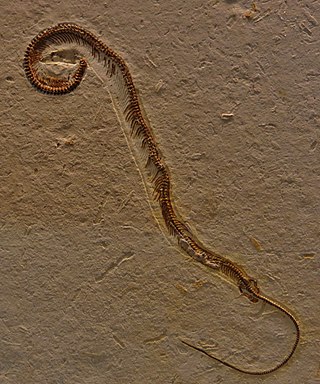
Ophidia is a group of squamate reptiles including modern snakes and reptiles more closely related to snakes than to other living groups of lizards.

Mosasaurs are an extinct group of large aquatic reptiles within the family Mosasauridae that lived during the Late Cretaceous. Their first fossil remains were discovered in a limestone quarry at Maastricht on the Meuse in 1764. They belong to the order Squamata, which includes lizards and snakes.

Aigialosauridae is a family of Late Cretaceous semiaquatic pythonomorph lizards closely related to the mosasaurs. Regarded by some paleontologists as a distinct monophyletic group and by others as an adaptive grade within the basal mosasauroids, recent molecular and morphological data suggests that they are the oldest known members of the lineage leading to the mosasaurs.

Dallasaurus is a basal mosasauroid from the Upper Cretaceous of North America. Along with Russellosaurus, Dallasaurus is one of the two oldest mosasauroid taxa currently known from North America. It is also one of the smallest known mosasaurines, measuring approximately 1 m (3.3 ft) in length.

Adriosaurus is an extinct genus of squamate which lived in what is now Slovenia and other parts of Europe during the Late Cretaceous. It was a small, snake-like reptile, with the type species Adriosaurus suessi measuring up to 30 cm (12 in) in length. Adriosaurus represents the first occurrence of vestigial limbs in fossil lizards, having lost its manus and forearm completely in order to elongate its axial skeleton. These unique anatomical features led to discussions of the evolutionary patterns of limb reduction in Squamata.

Kaganaias is an extinct genus of basal and oldest dolichosaur that lived in what is now Japan during the Early Cretaceous. Kaganaias was semi-aquatic and is the only known aquatic squamate known from before the Cenomanian stage of the Cretaceous. It is also the first to be found in an inland area, instead of on the coast where aquatic squamates are commonly found. Its generic name is derived from Kaga Province, the old name for the Ishikawa Prefecture where the specimens were found, while the species name hakusanensis comes from the mountain that gives its name to Hakusan the city near its find site. The geological formation in which the specimens were found, the Kuwajima Formation, stands alongside the Tetori River and has been the site of numerous other finds including molluscs, dinosaurs, fish, and pterosaurs.

Civico Museo di Storia Naturale di Trieste is a natural history museum in Trieste, northern Italy. It contains several collections, including more than two millions botanical, zoological, mineralogical, geological, and paleontological specimens.

Mosasauroidea is a superfamily of extinct marine lizards that existed during the Late Cretaceous. Basal members of this group consist of small semiaquatic forms with terrestrial limbs ("plesiopedal"), while laters members include larger fully aquatic paddle-limbed ("hydropedal") forms commonly known as mosasaurs. These were traditionally grouped within their own separate families, the Aigialosauridae and Mosasauridae respectively. However, phylogenetic studies have since found plesiopedal mosasauroids to be a non-monophyletic group, with some taxa nestled within the mosasaurids. Daniel Madzia and Andrea Cau in 2017 defined Mosasauroidea as "the most inclusive clade containing Mosasaurus hoffmannii and Aigialosaurus dalmaticus, but not Dolichosaurus longicollis, Adriosaurus suessi, or Pontosaurus lesinensis".

Yaguarasaurus is an extinct genus of mosasauroid from the Late Cretaceous (Turonian) period of Colombia, South America. The remains discovered were defined as a new genus and species of mosasaurid, Yaguarasaurus columbianus, by the Colombian paleontologist María Páramo, former director of the Museo de Geología José Royo y Gómez of INGEOMINAS in Bogotá. The first fossils remains of this animal suggested a cranial length of 47 centimetres (19 in) and a total length of 5 metres (16 ft); an additional skull that measures 87 centimetres (34 in) long implies a larger size.
Komensaurus is a genus of basal aigialosaurid mosasauroid from the Late Cretaceous period. It was found at Komen in Slovenia in limestone dating from the Cenomanian. It was earlier referred to as the "Trieste aigialosaur". In 2007, the type species Komensaurus carrolli was named. Its holotype, specimen MCSNT 11430, was discovered in Slovenia and lived alongside the related Carsosaurus.
Carsothrissops is an extinct genus of marine ray-finned fish that lived during the Cenomanian. It contains a single species, C. delorenzi from Komen, Slovenia.

Aigialosaurus is an extinct genus of Late Cretaceous marine or semiaquatic lizard classified as part of the family Aigialosauridae within the Mosasauroidea. Exclusively found in deposits of Cenomanian age near Hvar, Croatia, the genus contains one valid species, A. dalmaticus. According to recent molecular and morphological data, Aigialosaurus is the oldest known member of the lineage leading to large Cretaceous marine reptiles called mosasaurs, a group most closely related to snakes among living squamates. It was a relatively small reptile with a complete specimen measuring 65 cm (2.13 ft) long.

Opetiosaurus is an extinct genus of Late Cretaceous marine or semiaquatic lizard classified as part of the family Aigialosauridae within the Mosasauroidea. Exclusively found in deposits of Cenomanian age near Hvar, Croatia, the genus contain one valid species, O. bucchichi. It was a small reptile measuring 1 metre (3.3 ft) long.
Acteosaurus is an extinct genus of aquatic lizard that lived in the upper Cretaceous period. Its species, A. tommasinii and A. crassicostatus, were described in 1860 and 1993. Though A. crassicostatus is probably a junior synonym for Adriosaurus suessi, A. tommasinii was found to be similar to coniasaurs, mosasauroids, and a sister taxon to modern snakes in 2010.

(Georg) Andreas von Kornhuber was an Austrian naturalist and paleontologist.

Pannoniasaurus is an extinct genus of tethysaurine mosasauroid known from the Late Cretaceous Csehbánya Formation and Ajka Coal Formation of Hungary. It contains a single species, Pannoniasaurus inexpectatus, dubbed "unexpected" because it was discovered in freshwater sediments, unlike other mosasaurs, which were marine predators. It was a medium-sized mosasaur, reaching up to 6 metres (20 ft) in length.

Tetrapodophis is an extinct genus of lizard from the Early Cretaceous (Aptian) aged Crato Formation of Brazil. It has an elongated snake-like body, with four disproportionately short limbs.

This timeline of mosasaur research is a chronologically ordered list of important fossil discoveries, controversies of interpretation, and taxonomic revisions of mosasaurs, a group of giant marine lizards that lived during the Late Cretaceous Epoch. Although mosasaurs went extinct millions of years before humans evolved, humans have coexisted with mosasaur fossils for millennia. Before the development of paleontology as a formal science, these remains would have been interpreted through a mythological lens. Myths about warfare between serpentine water monsters and aerial thunderbirds told by the Native Americans of the modern western United States may have been influenced by observations of mosasaur fossils and their co-occurrence with creatures like Pteranodon and Hesperornis.

Dolichosauridae is a family of Cretaceous aquatic lizards. They are widely considered to be the earliest and most primitive members of Mosasauria, though some researchers have recovered them as more closely related to snakes.

















